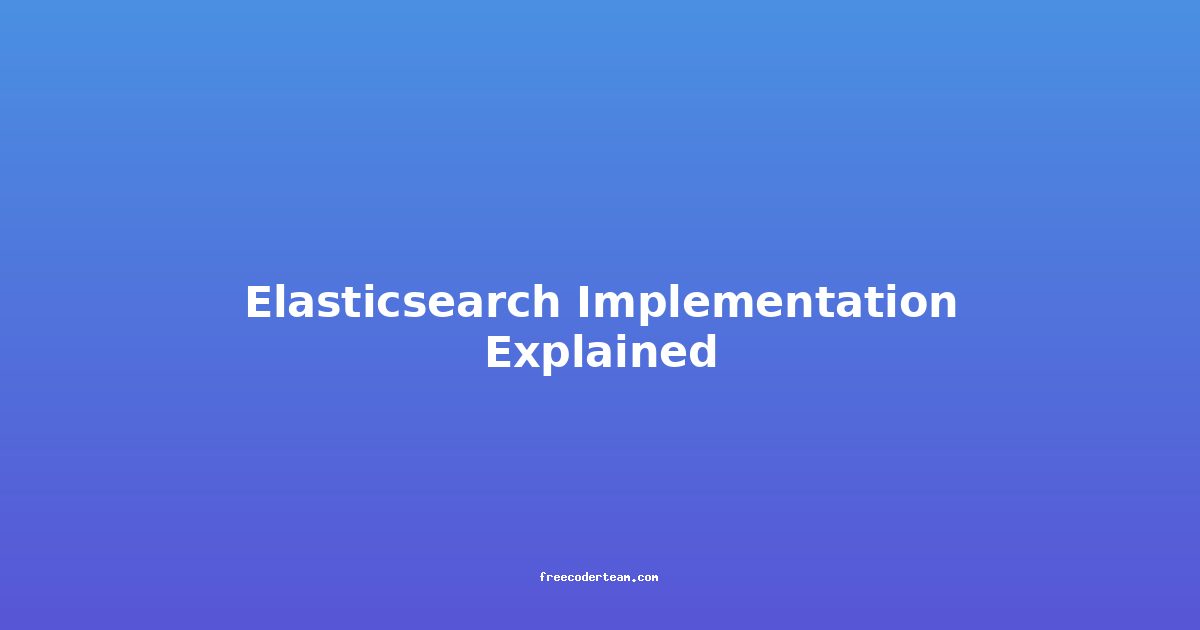Elasticsearch Implementation Explained: A Comprehensive Guide
Elasticsearch is a powerful, open-source search and analytics engine that has become a cornerstone for building scalable and performant search solutions. Whether you're a developer, data engineer, or architect, understanding how to implement Elasticsearch effectively can significantly enhance your ability to handle complex search and analysis tasks. In this blog post, we'll explore the key concepts, best practices, and actionable insights for implementing Elasticsearch in your projects.
Table of Contents
- Understanding Elasticsearch
- Key Concepts in Elasticsearch
- Practical Steps for Implementation
- Best Practices for Elasticsearch Implementation
- Real-World Examples
- Conclusion
Understanding Elasticsearch
Elasticsearch is built on top of the Apache Lucene library, providing a distributed, RESTful search and analytics engine. It's designed to handle large volumes of data and offers robust features for full-text search, aggregations, and real-time analytics. Whether you're building a simple search engine or a complex data analytics pipeline, Elasticsearch can be a game-changer.
Before diving into implementation, it's essential to understand the core concepts and architecture of Elasticsearch.
Key Concepts in Elasticsearch
Clusters, Nodes, and Shards
-
Cluster: A group of one or more nodes (servers) that work together to manage an index. A cluster is identified by a unique name, and by default, it's called "elasticsearch." Nodes in a cluster coordinate with each other to ensure high availability and fault tolerance.
-
Node: An instance of Elasticsearch that stores data, processes search queries, and participates in the cluster's operations. Nodes can be configured to serve specific roles, such as data nodes, master nodes, or ingest nodes.
-
Shards: An index in Elasticsearch is divided into multiple shards, which are essentially smaller partitions of the index. Sharding allows Elasticsearch to distribute data across multiple nodes, enabling horizontal scaling and improved performance.
Indices, Types, and Documents
-
Index: A collection of documents with a similar structure. Think of an index as a database in traditional relational databases. For example, you might have an "employees" index to store employee profiles.
-
Type: A logical category within an index. Types allow you to store different document structures within the same index. However, starting from Elasticsearch 7.x, the concept of types has been deprecated, and each index should have a single mapping.
-
Document: A JSON object that contains data. Documents are stored in indices and can be searched or analyzed. For example, an employee document might contain fields like "name," "age," and "department."
Practical Steps for Implementation
Step 1: Setting Up Elasticsearch
To get started with Elasticsearch, you can use one of the following methods:
-
Docker: Use Docker to run Elasticsearch in a container. This is a quick way to set up a development environment.
docker pull docker.elastic.co/elasticsearch/elasticsearch:7.17.0 docker run -p 9200:9200 -p 9300:9300 -e "discovery.type=single-node" docker.elastic.co/elasticsearch/elasticsearch:7.17.0 -
Official Installation: Download and install Elasticsearch from the official website. Follow the installation guide for your operating system.
Step 2: Designing Your Index Mapping
Index mapping defines the structure of your data. It tells Elasticsearch how to store and index each field in your documents. A well-designed mapping can improve search performance and ensure data consistency.
Here's an example of creating an index with a mapping:
PUT /employees
{
"mappings": {
"properties": {
"name": {
"type": "text"
},
"age": {
"type": "integer"
},
"department": {
"type": "keyword"
},
"hired_at": {
"type": "date"
}
}
}
}
Step 3: Indexing Data
Once the index is created, you can start indexing documents. Each document is identified by an ID, which can be generated automatically or specified explicitly.
Here's an example of indexing a document:
POST /employees/_doc/1
{
"name": "John Doe",
"age": 30,
"department": "Engineering",
"hired_at": "2023-01-15"
}
Step 4: Performing Search Operations
Elasticsearch provides powerful search capabilities. You can perform simple or complex queries using the Query DSL (Domain-Specific Language).
Example: Simple Search
To search for employees in the "Engineering" department:
GET /employees/_search
{
"query": {
"match": {
"department": "Engineering"
}
}
}
Example: Advanced Search with Aggregations
To count employees by department:
GET /employees/_search
{
"size": 0,
"aggs": {
"departments": {
"terms": {
"field": "department"
}
}
}
}
Best Practices for Elasticsearch Implementation
Optimizing Index Mapping
- Use Appropriate Data Types: Choose the right field types based on the data. For example, use
keywordfor exact matches andtextfor full-text search. - Avoid Over-Indexing: Only index fields that are necessary for search or aggregation. Over-indexing can increase storage requirements and slow down performance.
Handling Scaling and High Availability
- Sharding and Replication: Configure shards and replicas based on your data volume and performance requirements. Shards distribute data, while replicas ensure fault tolerance.
- Master-Elective Architecture: Use dedicated master nodes for cluster management and data nodes for storage and processing.
Monitoring and Performance Tuning
- Use Monitoring Tools: Leverage Elasticsearch's built-in monitoring features or integrate with tools like Kibana for real-time insights.
- Tune JVM Settings: Optimize JVM heap size and garbage collection settings based on your use case.
- Regularly Update Elasticsearch: Keep your Elasticsearch version up to date to benefit from performance improvements and security patches.
Real-World Examples
Example 1: Log Analysis with Elasticsearch
Elasticsearch is widely used for log analysis due to its ability to handle large volumes of data in real time. By integrating with tools like Logstash (for data ingestion) and Kibana (for visualization), you can create a powerful log management solution.
Workflow:
- Log Ingestion: Use Logstash to collect logs from various sources (e.g., servers, applications).
- Indexing: Logstash indexes the logs into Elasticsearch.
- Analysis: Use Kibana to create dashboards and visualizations for monitoring log patterns and anomalies.
Example 2: E-commerce Search
E-commerce platforms often use Elasticsearch to power their search functionality, allowing users to find products efficiently.
Workflow:
- Product Indexing: Index product data (e.g., name, price, category, description) into Elasticsearch.
- Search Queries: Allow users to search for products using full-text search, filters, and sorting.
- Personalization: Use aggregations to recommend products based on user behavior or preferences.
Conclusion
Elasticsearch is a versatile tool that can transform how you handle search and analytics tasks. By understanding its core concepts, following best practices, and leveraging its powerful features, you can build robust and scalable solutions.
Whether you're analyzing logs, powering a search engine, or performing real-time analytics, Elasticsearch provides the flexibility and performance needed for modern applications. Start with a solid understanding of its architecture and gradually explore advanced features as your use case evolves.
Remember, Elasticsearch is not just a search engine—it's a complete ecosystem for managing, analyzing, and visualizing data. With the right implementation, it can become a cornerstone of your data infrastructure.
If you have any questions or need further assistance with Elasticsearch implementation, feel free to reach out! Happy searching! 😊
Note: The examples and configurations provided are simplified for demonstration purposes. Always refer to the official Elasticsearch documentation for production-grade configurations.




